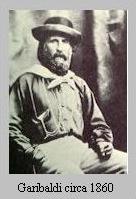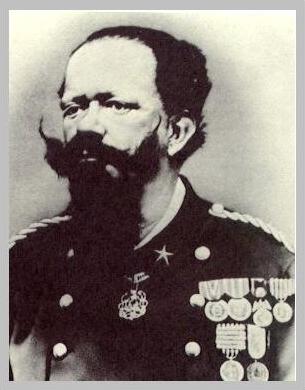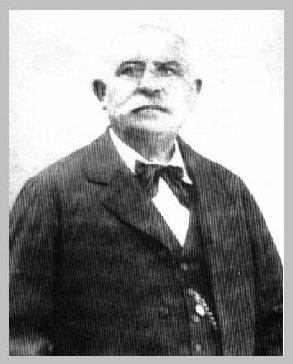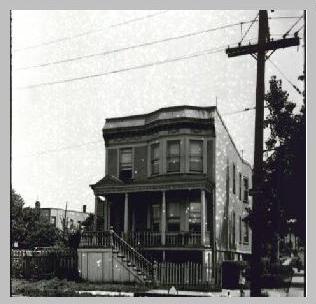Page 8 of 107
EMIGRATION AFTER UNIFICATION

| Prev Page | Prev Item | Contents | Index | Home Page | Next Item | Next Page |
Page 8 of 107
EMIGRATION AFTER UNIFICATION

When Garibaldi and his Red Shirts conquered Sicilia and presented the island, as a prize to Victor Emmanuel II, as part of the forming of the country of Italy, there were changes for the Sicilian families that were not always welcome. Only after 1870 could we Colloraffis call ourselves Italian. With this unification came some laws that our Sicilian family did not like. For example, all Italian men at age 18 had to serve in the army for two years. The Colloraffi family, as every Sicilian family did, considered their sons the future of the family. Sons were raised to honor and support their parents, not only emotionally, but financially. This was before the days of government help through pension programs. Is it any wonder that our families started to look beyond the seas of their beautiful island to live out their old age with their sons and families? If sons died in a war, who would support the aged parents? Who would continue the family business or farm the land?
Sons in Sicily were also responsible for helping their parents accumulate a dowry for each daughter. Often, the better the dowry, the better the marriage prospects. Traditionally, sons did not marry until after each sister was married, so that they could fulfill this obligation. This is one of the reasons that, as you read our family tree, you will see that the men are often five to fifteen years older than the women, when they married.

The first king of a unified
Italy
Victor Emmanuel II
There were other laws, with unification, that were not favorable to the Sicilian economic climate and may have been the cause of the economic depression that greatly affected Sicilians in the 1890 to 1900 time frame. Some of these laws had to do with agricultural production. For example, inheritance of land was affected. Prior to unification, land in Sicily was usually inherited by the oldest son in a family. This was changed by law so that only one half of the land could be given to the oldest son and the other half was divided among the remaining children. Over time, vast holdings which could provide a good living for one family, became small family vineyards or farms with depleted soil. Today, in Sicily, there are land records which have even one tree owned by several individuals!
Agriculture also became regulated.
After unification in 1870, Sicilians were forbidden to raise tobbaco or
even make cigars. The reason given for this was to allow the rest of Italy
to compete in this trade. My father, who loved his cigars, remembers his
emigrant grandfather and his namesake, Domenico, as always having a cigar
in his hand. In fact, my father told us, he would have an unlit cigar resting
in many rooms of his home, waiting for the chance to be smoked. I am sure
that he was not in favor of this restriction while he lived in Sicily.
Another possible reason
for members of the Colloraffi family to leave the beautiful island of Sicily,
is that the Sicilian education system was in shambles after the country
of Italy was created in 1870. Church lands were confiscated by the government
and many towns were left without schools or teachers, until public education
was establised by the new country. Before that, nuns, monks and priests
provided most of the education for Sicilian children. Also, it was nearly
unheard of for children of tradesmen and women to go "above their class"
and go to college in 19th century Sicily. By contrast, in America, anyone
was able to go to a university - as my father, the first generation born
in America, was able to do.
A further advantage of emigrating to America and the northern climate of a city like New York would be to escape the malaria that, prior to insect control and inoculations to prevent it, or medicine to treat it, was so devastating to Sicilian families. We know that an active Mt. Etna, kept one of our family members, who was visiting New York around 1910, in the USA. It could be that the earthquakes that are not uncommon in the area that our family lived, were another deciding factor in moving from Sicily. The largest and most devistating earth quake in European history killed over 150,000 people in the Messina area in 1907.
Like many other Sicilian families, our Colloraffi family started looking beyond their beautiful island to insure the wefare and prosparity of their sons and families. There were also economic possibilities for our hard working family in countries, other than Sicily, which was experiencing a serious economic depression in the late 1800's. An interesting story, later told in this book, is that of the Rosario Collorafi family, which moved from Patti to Tunisia and became major land and business owners in the beautiful seaside tow of Sousse.

Rosario Collorafi of
Patti, who emigrated with his family to Tunisia.
Pietro Collorafi, Rosario's brother, brought his family to New York City, New York around 1900. Even though separated by thousands of miles, the brother and cousins continued to remember and to write to each other.

Pietro Collorafi, brother
of Rosario, came from Patti to New York.
In 1901 my great-grandfather, Domenico left his lands and cobbler business in Sant' Agata di Militello and came to the Bronx, with his wife, Giuseppa Zingales Botta and three year old grand daughter, Rosalia Piscitello. They joined the majority of their children who had come to New York the year before.
In 1908, my grandfather, Vincenzo Colloraffi, married a beautiful young girl from his hometown and church, who had also emigrated with her family, Maria Modica.

This is the home at 1882
Barnes Avenue in the Bronx, New York, that Domenico Colloraffi, my great-grandfather,
bought and lived in .
Records from Ellis Island, where many emigrant's landed on their way to New York, indicate that the following family members came to the United States in the last part of the 19th century and early part of the 20th century. It should be noted that married women are listed by their maiden names, which were their legal names in Sicily from birth to death, and that this record should, in no way, be considered complete. For the most part, if a person traveled first or sometimes even as second class passengers, they would go directly into the port of New York, without stopping at Ellis Island. However, even then, records were kept on Ellis Island of the emigrants coming into the port of New York,through the ship manifests which were on file there.
This list indicates the
name, place of origin, year of entry
into the United States,
and the age of the passenger upon arriving:
Please note that all
of the Colloraffis or Collorafis are from Sicilia, Italia.
Sometimes the same person
is listed twice. This is because a person may have returned to Sicily and
then come back to the United States, latter.
COLLORAFFI
1. Vincenzo Colloraffi, Sant'
Agata di Militello, 1900 , 19.
2. Mi Filomenia Colloraffi,
Salina, 1914, 46.*
3. Maria Teresa Colloraffi,
Sant' Agata di Militello, 1900, 28.
4. Maria Colloraffi, Sant'
Agata di Militello, 1905, 28.
5. Maria Colloraffi, Sant'
Agata di Militello, 1905, 28.
6. Maria Colloraffi, Sant'
Agata di Militello, 1900, 23.
7. Guiseppe Colloraffi,
Sant' Agata di Militello, 1906, 16.
8. Giuseppa Colloraffi,
Sant' Agata di Militello, 1900, 21.
9. Giuseppe Colloraffi,
Sant' Agata di Militello, 1906, 17.
10. Giuseppa Colloraffi,
Caronia, Messina, 1909, 52.
11. Domenico Colloraffi,
Sant' Agata di Militello, 1901, 61.
12. Carmela Colloraffi,
Caronia, Sicily, 1906, 53.
13. Carmela Colloraffi,
Caronia, Sicily, 1906, 53.
14. Carlo Colloraffi, Sant'
Agata di Militello, 1906, 18.
15. Carlo Colloraffi, Sant'
Agata di Militello, 1906, 19.
16. Biagio Colloraffi, Sant'
Agata di Militello, 1905, 30.
17. Rosario Colloraffi,
S. Piero Patti, 1907, 24.
18. Carmela Colloraffi,
Sant' Agata di Militello, 1920, 19.
*I believe that this Filomenia
is really Nicollina Colloraffi or perhaps Nicollina
in the nickname for Filomenia.
Note: I have corrected
the spelling of the transcribers. For example,
Salina is spelled "Talina",
and Sant' Agata di Militello is spelled
"Sclgata Ma". Librizzi
is spelled "Librotti". San Piero Patti is spelled
"Spadafora". JA
COLLORAFI
1. Salvatore Collorafi, S.
Marina, Salina, Italy, 1920, 25.
2. Caterine Collorafi, Patti,
1899, 50.
3. Zuidaro Collorafi, Librizzi,
Italy, 1914, 28.
4. Salvatore Collorafi,
Salina, 1905, 5.
5. Pietro Collorafi, San
Piero Patti, 1905, 24.
6. Mario Collorafi, Librizzi,
Italy, 1914, 0.
7. Maria Collorafi, San
Piero Patti, 1903, 19.
8. Maria Collorafi, San
Piero Patti, 1903, 19.
9. Guiseppe Collorafi, San
Piero Patti, 1903, 23.
10. Guiseppe Collorafi,
San Piero Patti, 1903, 23.
11. Guiseppe Collorafi,
Librizzi, Italy, 1914, 26.
12. Giuseppe Collorafi,
Patti, 1900, 14.
13. Domenico Collorafi,
Librizzi, Italy, 1914, 2.
14. Anna Collorafi, Librizzi,
Italy, 1914, 3.
15. Anna Collorafi, Salina,
1905, 1.
16. Angelo Collorafi, Salina,
1905, 2.
You may notice that it looks as if some people are listed twice. This may be the case or it could be that they are cousins, named after the same grandparent. Also, you will see that the same family surname is sometimes spelled with one f and sometimes two. There is also two versions of the name Guiseppe/Giuseppe. This exists in our family to this day. JA
Other parts of our family
stayed in Sicilia, were respected, worked hard, and looked for education
and opportunities for their family and children. There were several mayors
of Sicilian towns in our family. In the mid 1800s, a Pietro Collorafi served
as Uffizialo dello Stato Civile del Commune di San Piero Patti. At the
beginning of 1900, two Colloraffis were Uffiziale dello Stato Civile di
Sant' Agata di Militello. First there was Biagio and then Vincenzo Colloraffi.
Some Colloraffi branches,
it is said, came to the United States and then went back to Sicilia. Many
Colloraffis moved to other parts of Italy, which offered more opportunities
for better jobs. Others emigrated to Australia, France, Germany, Canada,
Tunisia, Africa, South America and Mexico. Now our small family, of from
200 to 300 members, spelling the name as either Collorafi or Colloraffi
live around the world.

Domenico Collorafi of
Vallone Vina, son of Pietro Collorafi; remained in Sicilia.
Many of their family stories are included in this book. I have attempted to contact each Colloraffi in the world today and invite them to contribute to our family story. An interesting and rewarding part of my search for all of the Colloraffis alive today has been to reunite cousins or other relatives, who have not seen each other or have not known what happened to each other - over thousands of miles and as much as a hundred years.
Now, please pour yourself another glass of wine and read more about our Colloraffi family.
Page 8 of 107
| Prev Page | Prev Item | Contents | Index | Home Page | Next Item | Next Page |